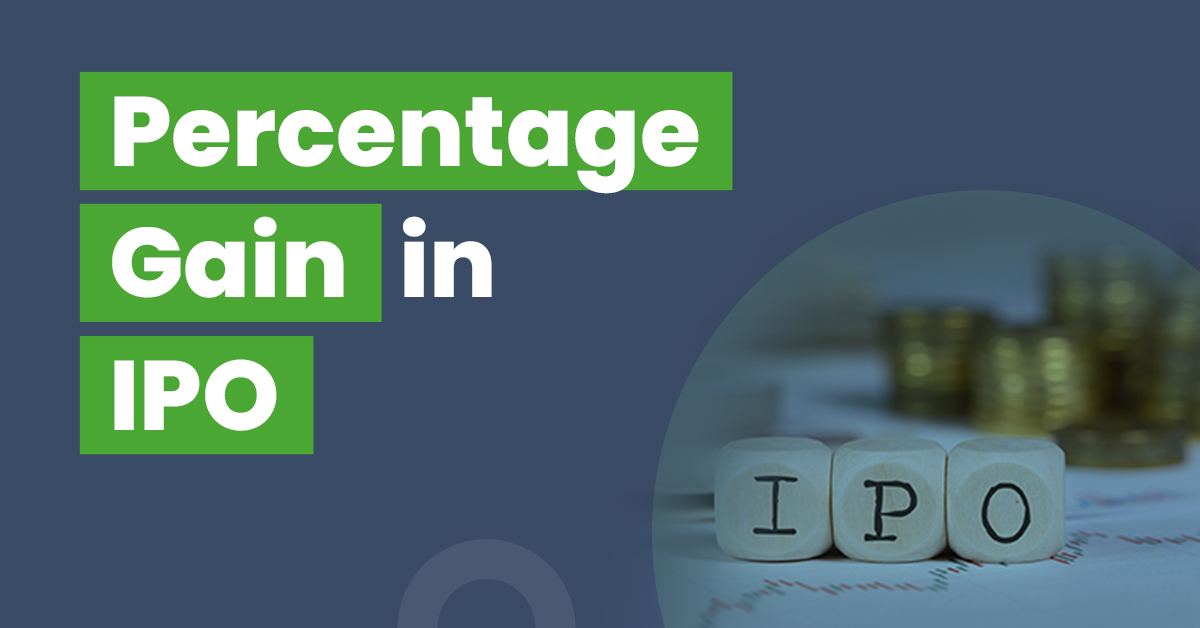Percentage Gain in IPO – Meaning, Importance & How to Calculate


Before calculating IPO profits, we need a basic idea about profit and loss. When the selling price of a stock is greater than its buying price, we can conclude that the trade is profitable.
The following sections will cover the percentage gains for IPOs and how to calculate them.
What Is Percentage Gain in an IPO?
A private company makes itself accessible for investment through an Initial Public Offering (IPO). Here, an investor may gain money if they sell their shares for more than they paid. Conversely, an investor incurs a loss if the buying price exceeds the selling price. If the selling and buying prices are the same, an investor has neither made a profit nor a loss.
The percentage gain is the most common method of calculating the loss or gain from an IPO. Investors can use the percentage gain over a fixed period (say, 1 year) to compare two investments.
How Is the Percentage Gain in IPOs Calculated?
The total profit is the difference between the selling price and the buying price. Then, to calculate the profit percentage, we have to divide the profits by the buying price and multiply the same by 100.
Percentage gain in IPO = [{(Selling Price – Buying Price)/ Buying Price}*100]
Why Is Calculating Percentage Gains Important?
Percentage gain is the easiest way to calculate how much profit you earned over an initial investment. Let us use an example to demonstrate this.
Suppose an investor has invested in two assets: Asset A and Asset B. The buying price of Asset A is ₹ 1,000, while the cost price of Asset B is ₹100. On the listing day, both assets made a profit of ₹100.
Though the gain amounts of both these assets are similar, on calculating the gain percentage, we find that Asset B has given a better return than Asset A. For Asset A, the profit percentage was 10%, while for Asset B, the profit percentage was 100%.
So, an investor could have gained a lot more if they had invested more in Asset B. Thus, for analysing the performance of assets, calculating the gain percentage is a simple but effective process.
Factors on Which the Percentage Gain Depends
There are many factors on which the percentage gain in an IPO depends. These are
- Dividends: Dividends are the portion of profits that a corporation pays its stockholders to encourage them to stay invested. A company’s board of directors decides the dividend yield. Companies pay out dividends on a per-share basis.
- Brokerage Fees: You must carry out the transaction via broker when investing in securities like stocks and bonds. For this service, whether you buy or sell, you must pay a brokerage fee for each transaction. The standard brokerage fee is from 0.25 to 0.75% of the total trading volume.
- Capital Gains Tax: Depending on how long you hold an asset, you must pay capital gains tax when selling it. You must pay Short-Term Capital Gains (STCG) tax if you sell an equity investment within a year of buying it. Long-Term Capital Gains (LTCG) tax will only apply if you hold your equity assets for a year or more. In that scenario, gains up to ₹1 lakh are exempt from tax, and for gains above ₹1 lakh 10% tax is levied.
Final Word
Every investor should know and learn how to use the percentage gain formula. It is an essential tool in analysing investments and must be assessed before investing by looking at the anticipated returns. It provides an easy way to compare the past returns of different types of investments, and you can easily calculate them using a calculator.
Frequently Asked Questions (FAQs)
What are the different types of IPO?
There are mainly two types of IPOs – fixed-price issues and book-building issues.
What is a Shelf Prospectus?
A corporation must submit a shelf prospectus if it wants to issue to raise money from public multiple times during the year. This saves the company from the tedious and costly affair to filing the prospectus for each issue separately.
What is an Information Memorandum?
If there are changes in the company’s economic condition after it has filed its prospectus, it has to file an Information Memorandum to provide an update.
What is ASBA?
Application Supported by Blocked Amount or ASBA is a mechanism used while applying for an IPO. This process blocks the required amount of money in your bank account, which can only be used for investing in the IPO.




